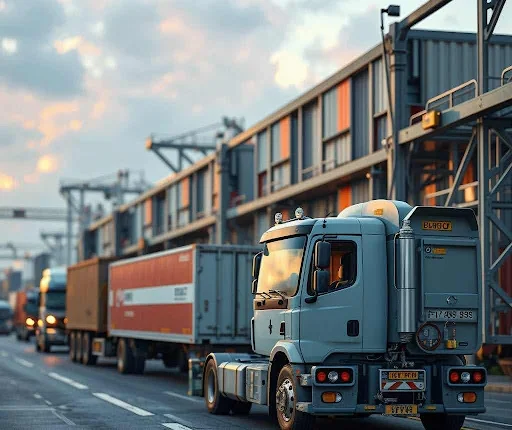Moving the Digital Carton: Why Freight Shipping Powers Online Retail
The online checkout button promises instant gratification, yet the items behind that click may be sitting thousands of miles from a consumer’s doorstep. Modern e-commerce only works because high volume transport networks keep inventory flowing from factories to fulfillment centers and finally to homes. Industry analysts project that nearly twenty four percent of all retail spending will happen online by twenty twenty six . To meet that demand merchants rely on Freight Shipping solutions that move pallets more efficiently than small parcels ever could.
From Factory Gate to Front Door
Most direct to consumer brands now manufacture overseas, then stage inventory inside regional distribution hubs. Anything heavier than about one hundred fifty pounds or larger than thirty inches cubed qualifies as freight rather than parcel . By loading stock on pallets and combining multiple orders in a single trailer, sellers shrink the cost per unit compared to mailing items individually. That margin relief lets startups offer free shipping thresholds and loyalty perks that once belonged only to giants.
Scale Without the Warehouse Bloat
Carrying enough stock to ride seasonal spikes can tie up serious cash. Freight Shipping enables a hub and spoke playbook where merchants send large restock loads to third party centers and replenish micro fulfillment sites just in time. Because a single truck can hold up to twenty six pallets , one weekly inbound delivery may cover days of web orders. The model unlocks these benefits:
- Lower rent bills, since bulk inventory sits in suburban hubs instead of premium urban footprints
- Fewer stockouts, as safety stock arrives in one consolidated drop rather than dozens of parcel cartons
- Flexibility to pivot between carriers when pricing or capacity shifts
Thanks for reading—why not stick around and see what else is new?
Inventory Visibility Becomes a Growth Lever
Cloud based management tools now track each pallet scan from factory dock to fulfillment shelf. Real time data means planners can launch a flash sale the moment fresh goods clear customs, confident that the system will reroute inventory to the best shipping zones. ShipBob’s market guide notes that brands expanding internationally lean on freight to seed inventory in new regions before demand even materializes . That proactive staging shortens delivery promises, boosts conversion rates, and keeps ad spend efficient.
Sustainability Meets Speed
Contrary to the image of smoky eighteen wheelers, a single consolidated truck run often produces fewer emissions per item than a parade of smaller vans. Rail intermodal lanes cut fuel burn further by letting locomotives haul the heavy miles while trucks handle final legs. Merchants then market the reduced carbon footprint right alongside two day delivery guarantees, satisfying shoppers who want both speed and responsibility.
Future Proofing Against Supply Chain Shocks
The pandemic taught retailers that freight capacity can evaporate overnight. Brands that cultivate relationships with multiple carriers and shift modes—such as less than truckload for small batch launches and full truckload during holiday surges—ride out volatility better than those locked into one path. Expert blogs recommend learning the basics of full truckload, less than truckload, partial truckload, intermodal, and expedited freight so teams can switch quickly when ports jam or fuel prices spike .
Key Ways Freight Shipping Accelerates E Commerce Growth
- Economies of distance: Transporting one large load is generally cheaper than sending many parcels, enabling free shipping offers that boost cart size
- Faster restocks: Direct lanes from factory to fulfillment center keep inventory levels stable, preventing lost sales from stockouts
- Geographic expansion: Pre positioning pallets abroad slashes delivery times for international customers and opens new revenue streams
- Return management: Bulk reverse shipments move unsold or returned goods back to refurb centers efficiently, lowering refurbishment costs
- Promotional agility: Brands can time big marketing pushes with scheduled freight arrivals, ensuring items are on the shelf when ads go live
Case Snapshot
A wellness brand launching in the United States used ocean containers to bring product in bulk, then broke the load into weekly less than truckload moves to three regional partners. Within ninety days the company cut average delivery time from six days to three and trimmed freight spend by thirty percent versus an all parcel approach. The savings funded same day local delivery pilots that drove a ten percent lift in repeat purchases.
Conclusion
Digital checkout trends show no signs of slowing, but customer patience is shortening. Freight networks equipped with real time tracking, dynamic routing, and shared visibility dashboards will act as the backbone of next generation retail. Brands that master these lanes can promise reliable two day service even for bulky products like fitness equipment or home furniture—categories once deemed too heavy for fast shipping.
Frequently Asked Questions
How hard is it for a small seller to start using freight instead of parcel?
Many third party logistics providers bundle services so newcomers can book pallet moves without owning a loading dock. They supply liftgate trucks, handle paperwork, and negotiate rates, making the transition straightforward even for a one person shop.
Does shifting to freight mean I need my own warehouse?
No. Most growing merchants rely on outsourced fulfillment centers. You send pallets in bulk, they store items and pick individual orders as they arrive. This hybrid approach captures freight economies of scale while keeping fixed real estate costs low.
Arishekar N. – Director of Marketing & Business Development, AMZ Prep
Arishekar N. leads marketing and business development at AMZ Prep, helping scale operations from startup to processing 50+ million units annually for 7,200+ Amazon sellers worldwide.
With 12+ years in the Amazon ecosystem, he has guided sellers from garage setups to 8-figure brands, driving 200% average revenue growth for AMZ Prep clients. His achievements include 78+ successful Seller Fulfilled Prime implementations and launching the industry’s first dedicated prep center tech platform.
Previously, Arishekar was Senior Director of Marketing at SellerApp, where he empowered sellers through data-driven insights and automation. He has also held strategic roles at IBM, HCL, Star Group, and NASSCOM startups—combining enterprise expertise with entrepreneurial agility.
A frequent speaker at events like Prosper Show and Seller Summit, Arishekar is known for his actionable advice on Amazon optimization, supply chain tech, and global marketplace expansion. Connect with him on LinkedIn or read his columns in E-Commerce Times.
Specialties: Amazon FBA | Seller Fulfilled Prime | Global Expansion | E-commerce Ops | Supply Chain Tech | Performance Marketing
There’s plenty more where that came from—browse our other helpful content!







